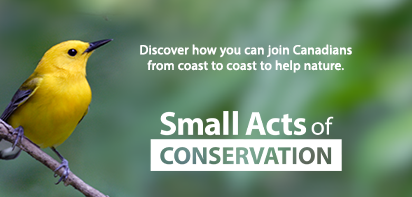From barren ground to lush forest

Native tree seedlings were planted at the site (Photo by Aaron Dowding/NCC staff)
Imagine an expanse of coastal forest where hundreds of migratory bird species stop to feed. Ocean sounds and bird calls can be heard as visitors wander down the twisting trail, becoming enveloped in shrubs and greenery that shield the ocean breeze. While it may take a few generations to develop, this is the dream for the Grand Manan Migratory Bird Nature Reserve.
On the southern coast of Grand Manan Island, New Brunswick, this nature reserve looks out into the opening of the Bay of Fundy and the vast Atlantic Ocean. It is part of the Grand Manan Island Migratory Bird Sanctuary (MBS), an important migration and wintering area for a variety of waterfowl. Nearly 200 bird species have been recorded on the nature reserve, including several at risk.
The birds have not been the only occupants of the land. A family farm once sat on a small section of the property (Henderson's Point) until the 1970s, when it was abandoned and eventually used as a gravel pit. The newly barren landscape in this part of the nature reserve was left alone for the vegetation to regrow naturally, but it struggled. The ground had become hard and compact, preventing plants from returning to some areas of the site.
“It reminded us a lot of what a post glacial environment might have looked like," says Aaron Dowding, New Brunswick stewardship manager for the Nature Conservancy of Canada (NCC). Aaron knew from the start that the nature reserve would eventually return to its original beauty; it just needed a little help.

Existing soil was loosened through the creation of pits and mounds (Photo by Aaron Dowding/NCC staff)
In 2023, after two years of planning and preparation, Aaron arrived on the island with a team to begin the rewilding process. First, they had to address the lack of plant-friendly soil. Rather than bringing in trucks full of topsoil, they wanted to work with what the site provided as much as possible. They started by loosening the existing soil. Using an excavator, they dug holes into the earth in a checkerboard-like pattern, creating pits and mounds of loose soil all over the former gravel pit.
"If you walk into the woods,” explains Aaron, “the trees naturally fall over, either from wind or age, and the roots pull up and create an uneven surface.” This was the landscape that the team tried to replicate. The loose soil from these natural pits and mounds is better able to retain moisture and allows roots to push deeper into the ground for a better chance of survival. It is an approach to rewilding that was coined the “rough and loose” technique by its inventor, David Polster.
The team also had to ensure that the newly loosened soil and young tree seedlings would not be trampled on by unsuspecting human travelers. Before the excavation, a multitude of unofficial trails littered the area, used by members of the local community to travel between commonly frequented areas on the island.
“We knew we had to maintain some of those trails because of their importance to people on the island,” says Aaron. The team spoke to as many locals as they could to establish which trails were the most important to the community. They used this knowledge to maintain a few official trails through the nature reserve. They marked some of the old trails, and filled in the remaining ones with the “rough and loose” soil to invite plant growth. These old paths were blocked off with rows of boulders to remind users of their decommissioned status.

Fully grown snags were installed to encourage the bird-assisted restoration process (Photo by Aaron Dowding/NCC staff)
Next, it was time to plant new trees. Aaron and the team carefully selected an assortment of early successional hardwood species, the first species that would naturally grow back after a disturbance in nature. These trees had to be native to the area, be able to survive the harsh soil conditions and thrive in a coastal environment. Some were chosen for their additional benefits to the area. Bebb’s willow, grey birch and white birch seeds are light and will travel easily in the wind, spreading trees quickly over the barren area. Green alder is a nitrogen fixer, meaning it will pull nitrogen from the air and store it in its roots, helping to improve soil conditions.
The team spread seeds collected from local staghorn sumac and red osier dogwood. They also planted a few mid-successional trees that generally grow back second, such as red oak, red maple, white spruce and tamarack. By the time the project was finished in 2024, a total of 4,000 trees had been planted.
The final component of the project was a bit more experimental. Led by Courtney Cameron, a former NCC intern and then a student at the University of Victoria, the experiment was called “bird-assisted restoration.” The idea is to use birds’ behaviour and excrement to naturally spread seeds over the barren area. In Courtney’s words, it is “restoration for the birds, by the birds.”
The team worked with a local contractor to install six fully grown trees in the middle of the more barren areas on the property. The intention was not for these trees to survive, but for them to become snags that birds use for resting, feeding and calling. Birds eat seeds, and so as they sit on the snags and their excrement disperses the seeds onto the ground around them.
"Normally, birds feed along the edge of the forest," explains Courtney, "but if you have the birds coming to the centre, then you might have these little focal areas of regrowth." This natural spread of seeds also promotes plant-life diversity.
The rewilding of the former gravel pit in the Grand Manan Migratory Bird Nature Reserve was made possible thanks to TD Bank Group and the Nature Smart Climate Solutions Fund. Their support helps fund landscape restoration projects across Canada.
Though the regrowth process has been kick-started, it will take generations for this part of the nature reserve to become the lush green forest that we all imagine. For now, all the land needs is a bit of monitoring to ensure that it is on track.
Nature is powerful, but sometimes, it needs a little help to work its magic.




